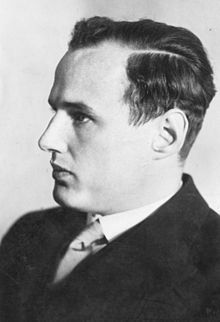Von Ardenne
| Manfred von Ardenne | |
|---|---|

Ardenne in 1930
|
|
| Born | 20 January 1907 Hamburg, German Empire |
| Died | 26 May 1997 (aged 90) Dresden, Germany |
| Residence | Dresden, Germany |
| Nationality | German |
| Citizenship | Germany |
| Known for |
Soviet atomic bomb project electron microscopy isotope separation cathode-ray tube |
| Awards |
Stalin Prize (1947, 1953) National Prize of East Germany Lenin Medal (1970) Colani Design France Prize (1993) |
| Scientific career | |
| Fields | Applied Physics |
| Institutions |
Soviet atomic bomb project TU Dresden |
| Influenced | Siegmund Loewe |
Manfred von Ardenne (20 January 1907 – 26 May 1997) was a German research and applied physicist and inventor. He took out approximately 600 patents in fields including electron microscopy, medical technology, nuclear technology, plasma physics, and radio and television technology. From 1928 to 1945, he directed his private research laboratory Forschungslaboratorium für Elektronenphysik. For ten years after World War II, he worked in the Soviet Union on their atomic bomb project and was awarded a Stalin Prize. Upon his return to the then East Germany, he started another private laboratory, Forschungsinstitut Manfred von Ardenne.
The stormy life of von Ardenne's grandmother, Elisabeth von Ardenne (1853–1952), is said to have been be the inspiration for Effi Briest by Theodor Fontane, one of the most famous German realist novels.
Born in 1907 in Hamburg to a wealthy aristocratic family, Ardenne was the oldest of five children. In 1913, Ardenne's father, assigned to the Kriegsministerium, moved to Berlin. From Ardenne's earliest youth, he was intrigued by any form of technology, and this was fostered by his parents. Ardenne's early education was at home through private teachers. In Berlin, from 1919, Ardenne attended the Realgymnasium, where he pursued his interests in physics and technology. In a school competition, he submitted models of a camera and an alarm system, for which he was awarded first place.
...
Wikipedia
